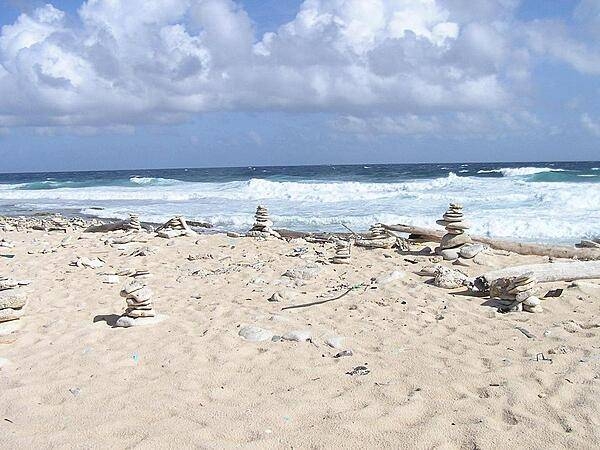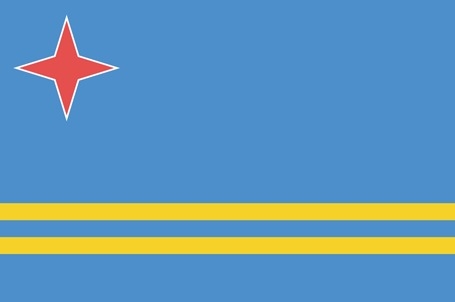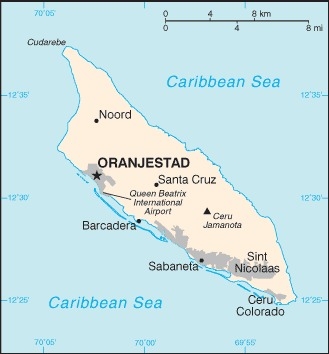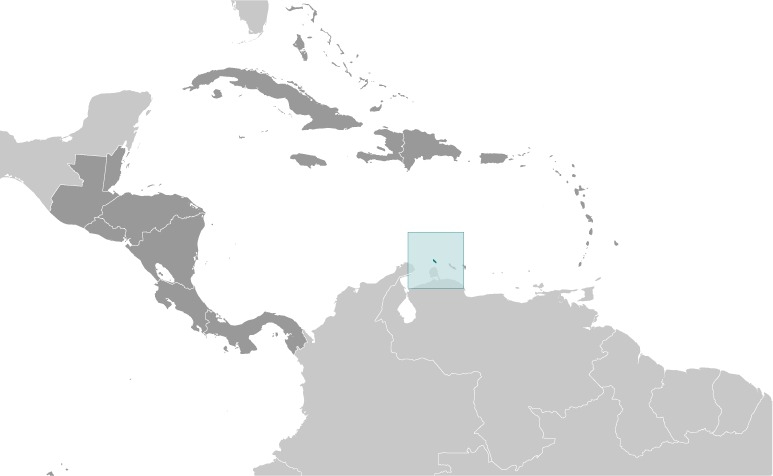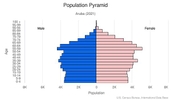Introduction
Background
Discovered and claimed for Spain in 1499, Aruba was acquired by the Dutch in 1636. The island's economy has been dominated by three main industries. A 19th century gold rush was followed by prosperity brought on by the opening in 1924 of an oil refinery. The last decades of the 20th century saw a boom in the tourism industry. Aruba seceded from the Netherlands Antilles in 1986 and became a separate, semi-autonomous member of the Kingdom of the Netherlands. Movement toward full independence was halted at Aruba's request in 1990.
Visit the Definitions and Notes page to view a description of each topic.
Geography
Location
Caribbean, island in the Caribbean Sea, north of Venezuela
Geographic coordinates
12 30 N, 69 58 W
Map references
Central America and the Caribbean
Area - comparative
slightly larger than Washington, DC
Land boundaries
total: 0 km
Coastline
68.5 km
Maritime claims
territorial sea: 12 nm
exclusive economic zone: 200 nm
Climate
tropical marine; little seasonal temperature variation
Terrain
flat with a few hills; scant vegetation
Elevation
highest point: Ceru Jamanota 188 m
lowest point: Caribbean Sea 0 m
Natural resources
NEGL; white sandy beaches foster tourism
Land use
agricultural land: 11.1% (2018 est.)
arable land: 11.1% (2018 est.)
permanent crops: 0% (2018 est.)
permanent pasture: 0% (2018 est.)
forest: 2.3% (2018 est.)
other: 86.6% (2018 est.)
Population distribution
most residents live in or around Oranjestad and San Nicolaas; most settlments tend to be located on the less mountainous western side of the island
Natural hazards
hurricanes; lies outside the Caribbean hurricane belt and is rarely threatened
Geography - note
a flat, riverless island renowned for its white sand beaches; its tropical climate is moderated by constant trade winds from the Atlantic Ocean; the temperature is almost constant at about 27 degrees Celsius (81 degrees Fahrenheit)
People and Society
Nationality
noun: Aruban(s)
adjective: Aruban; Dutch
Ethnic groups
Aruban 66%, Colombian 9.1%, Dutch 4.3%, Dominican 4.1%, Venezuelan 3.2%, Curacaoan 2.2%, Haitian 1.5%, Surinamese 1.2%, Peruvian 1.1%, Chinese 1.1%, other 6.2% (2010 est.)
note: data represent population by country of birth
Languages
Papiamento (official) (a creole language that is a mixture of Portuguese, Spanish, Dutch, English, and, to a lesser extent, French, as well as elements of African languages and the language of the Arawak) 69.4%, Spanish 13.7%, English (widely spoken) 7.1%, Dutch (official) 6.1%, Chinese 1.5%, other 1.7%, unspecified 0.4% (2010 est.)
Religions
Roman Catholic 75.3%, Protestant 4.9% (includes Methodist 0.9%, Adventist 0.9%, Anglican 0.4%, other Protestant 2.7%), Jehovah's Witness 1.7%, other 12%, none 5.5%, unspecified 0.5% (2010 est.)
Age structure
0-14 years: 17.55% (male 10,524/female 10,437)
15-24 years: 12.06% (male 7,231/female 7,175)
25-54 years: 40.54% (male 23,387/female 25,029)
55-64 years: 14.79% (male 8,285/female 9,383)
65 years and over: 15.05% (male 7,064/female 10,913) (2020 est.)
Dependency ratios
total dependency ratio: 47
youth dependency ratio: 25.6
elderly dependency ratio: 21.5
potential support ratio: 4.7 (2020 est.)
Median age
total: 39.9 years
male: 38.2 years
female: 41.5 years (2020 est.)
Population distribution
most residents live in or around Oranjestad and San Nicolaas; most settlments tend to be located on the less mountainous western side of the island
Urbanization
urban population: 43.9% of total population (2021)
rate of urbanization: 0.77% annual rate of change (2020-25 est.)
Major urban areas - population
30,000 ORANJESTAD (capital) (2018)
Sex ratio
at birth: 1.02 male(s)/female
0-14 years: 1.01 male(s)/female
15-24 years: 1.01 male(s)/female
25-54 years: 0.93 male(s)/female
55-64 years: 0.88 male(s)/female
65 years and over: 0.65 male(s)/female
total population: 0.9 male(s)/female (2020 est.)
Infant mortality rate
total: 12.39 deaths/1,000 live births
male: 16.89 deaths/1,000 live births
female: 7.81 deaths/1,000 live births (2021 est.)
Life expectancy at birth
total population: 77.76 years
male: 74.66 years
female: 80.93 years (2021 est.)
Drinking water source
improved: urban: 98.1% of population
rural: 98.1% of population
total: 98.1% of population
unimproved: urban: 1.9% of population
rural: 1.9% of population
total: 1.9% of population (2015 est.)
Sanitation facility access
improved: urban: 97.7% of population
rural: 97.7% of population
total: 97.7% of population
unimproved: urban: 2.3% of population
rural: 2.3% of population
total: 2.3% of population (2015 est.)
Literacy
definition: age 15 and over can read and write
total population: 97.8%
male: 97.8%
female: 97.8% (2018)
School life expectancy (primary to tertiary education)
total: 14 years
male: 13 years
female: 14 years (2012)
Environment
Environment - current issues
difficulty in properly disposing of waste produced by large numbers of tourists; waste burning that occurs in the landfill causes air pollution and poses an environmental and health risk; ocean environmental damage due to plastic pollution
Air pollutants
carbon dioxide emissions: 0.88 megatons (2016 est.)
Climate
tropical marine; little seasonal temperature variation
Land use
agricultural land: 11.1% (2018 est.)
arable land: 11.1% (2018 est.)
permanent crops: 0% (2018 est.)
permanent pasture: 0% (2018 est.)
forest: 2.3% (2018 est.)
other: 86.6% (2018 est.)
Urbanization
urban population: 43.9% of total population (2021)
rate of urbanization: 0.77% annual rate of change (2020-25 est.)
Revenue from forest resources
forest revenues: 0% of GDP (2017 est.)
country comparison to the world: 162Waste and recycling
municipal solid waste generated annually: 88,132 tons (2013 est.)
municipal solid waste recycled annually: 9,695 tons (2013 est.)
percent of municipal solid waste recycled: 11% (2013 est.)
Government
Country name
conventional long form: Country of Aruba
conventional short form: Aruba
local long form: Land Aruba (Dutch); Pais Aruba (Papiamento)
local short form: Aruba
etymology: the origin of the island's name is unclear; according to tradition, the name comes from the Spanish phrase "oro huba" (there was gold), but in fact no gold was ever found on the island; another possibility is the native word "oruba," which means "well-situated"
Government type
parliamentary democracy; part of the Kingdom of the Netherlands
Dependency status
constituent country of the Kingdom of the Netherlands; full autonomy in internal affairs obtained in 1986 upon separation from the Netherlands Antilles; Dutch Government responsible for defense and foreign affairs
Capital
name: Oranjestad
geographic coordinates: 12 31 N, 70 02 W
time difference: UTC-4 (1 hour ahead of Washington, DC, during Standard Time)
etymology: translates as "orange town" in Dutch; the city is named after William I (1533-1584), Prince of Orange, the first ruler of the Netherlands
Administrative divisions
none (part of the Kingdom of the Netherlands)
note: Aruba is one of four constituent countries of the Kingdom of the Netherlands; the other three are the Netherlands, Curacao, and Sint Maarten
Independence
none (part of the Kingdom of the Netherlands)
National holiday
National Anthem and Flag Day, 18 March (1976)
Constitution
history: previous 1947, 1955; latest drafted and approved August 1985, enacted 1 January 1986 (regulates governance of Aruba but is subordinate to the Charter for the Kingdom of the Netherlands); in 1986, Aruba became a semi-autonomous entity within the Kingdom of the Netherlands
Legal system
civil law system based on the Dutch civil code
Citizenship
see the Netherlands
Suffrage
18 years of age; universal
Executive branch
chief of state: King WILLEM-ALEXANDER of the Netherlands (since 30 April 2013); represented by Governor General Alfonso BOEKHOUDT (since 1 January 2017)
head of government: Prime Minister Evelyn WEVER-CROES (since 17 November 2017)
cabinet: Council of Ministers elected by the Legislature (Staten)
elections/appointments: the monarchy is hereditary; governor general appointed by the monarch for a 6-year term; prime minister and deputy prime minister indirectly elected by the Staten for 4-year term; election last held on 25 June 2021 (next to be held by June 2026)
election results: as leader of the majority party of the ruling coalition, Evelyn WEVER-CROES (MEP) elected prime minister; percent of legislative vote - NA
Legislative branch
description: unicameral Legislature or Staten (21 seats; members directly elected in a single nationwide constituency by proportional representation vote; members serve 4-year terms)
elections: last held on 25 June 2021 (next to be held in June 2025)
election results: percent of vote by party MEP 35.3%, AVP 31.3%, ROOTS 9.4%, MAS 8%, Accion21 5.8%; seats by party - MEP 9, AVP 7, ROOTS 2, MAS 2, Accion21 1
Judicial branch
highest courts: Joint Court of Justice of Aruba, Curacao, Sint Maarten, and of Bonaire, Sint Eustatius and Saba or "Joint Court of Justice" (sits as a 3-judge panel); final appeals heard by the Supreme Court in The Hague, Netherlands
judge selection and term of office: Joint Court judges appointed for life by the monarch
subordinate courts: Court in First Instance
Political parties and leaders
Accion21 [Miguel MANSUR]
Aruban People's Party or AVP [Michiel "Mike" EMAN]
Democratic Electoral Network or RED [L.R. CROES]
Movimiento Aruba Soberano or MAS [Marisol LOPEZ-TROMP]
People's Electoral Movement Party or MEP [Evelyn WEVER-CROES]
Pueblo Orguyoso y Respeta or POR [O.E. ODUBER]
RAIZ (ROOTS) [Ursell ARENDS]
Real Democracy or PDR [Andin BIKKER]
International organization participation
Caricom (observer), FATF, ILO, IMF, Interpol, IOC, ITUC (NGOs), UNESCO (associate), UNWTO (associate), UPU
Diplomatic representation in the US
chief of mission: none (represented by the Kingdom of the Netherlands); note - Guillfred BESARIL (since 20 November 2017) is Minister Plenipotentiary of Aruba, seated with his cabinet in the Aruba House (Arubahuis) in The Hague
none (represented by the Kingdom of the Netherlands) note - there is a Minister Plenipotentiary for Aruba, Rendolf "Andy" LEE, at the Embassy of the Kingdom of the Netherlands
Diplomatic representation from the US
embassy: the US does not have an embassy in Aruba; the Consul General to Curacao is accredited to Aruba
Flag description
blue, with two narrow, horizontal, yellow stripes across the lower portion and a red, four-pointed star outlined in white in the upper hoist-side corner; the star represents Aruba and its red soil and white beaches, its four points the four major languages (Papiamento, Dutch, Spanish, English) as well as the four points of a compass, to indicate that its inhabitants come from all over the world; the blue symbolizes Caribbean waters and skies; the stripes represent the island's two main "industries": the flow of tourists to the sun-drenched beaches and the flow of minerals from the earth
National symbol(s)
Hooiberg (Haystack) Hill; national colors: blue, yellow, red, white
National anthem
name: "Aruba Deshi Tera" (Aruba Precious Country)
lyrics/music: Juan Chabaya 'Padu' LAMPE/Rufo Inocencio WEVER
note: local anthem adopted 1986; as part of the Kingdom of the Netherlands, "Het Wilhelmus" is official (see Netherlands)
Economy
Economic overview
Tourism, petroleum bunkering, hospitality, and financial and business services are the mainstays of the small open Aruban economy.
Tourism accounts for a majority of economic activity; as of 2017, over 2 million tourists visited Aruba annually, with the large majority (80-85%) of those from the US. The rapid growth of the tourism sector has resulted in a substantial expansion of other activities. Construction continues to boom, especially in the hospitality sector.
Aruba is heavily dependent on imports and is making efforts to expand exports to improve its trade balance. Almost all consumer and capital goods are imported, with the US, the Netherlands, and Panama being the major suppliers.
In 2016, Citgo Petroleum Corporation, an indirect wholly owned subsidiary of Petroleos de Venezuela SA, and the Government of Aruba signed an agreement to restart Valero Energy Corp.'s former 235,000-b/d refinery. Tourism and related industries have continued to grow, and the Aruban Government is working to attract more diverse industries. Aruba's banking sector continues to be a strong sector; unemployment has significantly decreased.
Real GDP (purchasing power parity)
$4.158 billion (2017 est.)
$4.05 billion (2017 est.)
$4.107 billion (2016 est.)
Real GDP growth rate
1.2% (2017 est.)
-0.1% (2016 est.)
-0.4% (2015 est.)
Real GDP per capita
$37,500 (2017 est.)
$38,442 (2017 est.)
$37,300 (2016 est.)
GDP (official exchange rate)
$2.7 billion (2017 est.)
Inflation rate (consumer prices)
-0.5% (2017 est.)
-0.9% (2016 est.)
Credit ratings
Fitch rating: BB (2020)
Standard & Poors rating: BBB+ (2013)
GDP - composition, by sector of origin
agriculture: 0.4% (2002 est.)
industry: 33.3% (2002 est.)
services: 66.3% (2002 est.)
GDP - composition, by end use
household consumption: 60.3% (2014 est.)
government consumption: 25.3% (2015 est.)
investment in fixed capital: 22.3% (2014 est.)
investment in inventories: 0% (2015 est.)
exports of goods and services: 70.5% (2015 est.)
imports of goods and services: -76.6% (2015 est.)
Agricultural products
aloes; livestock; fish
Industries
tourism, petroleum transshipment facilities, banking
Labor force
51,610 (2007 est.)
note: of the 51,610 workers aged 15 and over in the labor force, 32,252 were born in Aruba and 19,353 came from abroad; foreign workers are 38% of the employed population
Labor force - by occupation
agriculture: NA
industry: NA
services: NA
note: most employment is in wholesale and retail trade, followed by hotels and restaurants
Household income or consumption by percentage share
lowest 10%: NA
highest 10%: NA
Budget
revenues: 681.6 million (2017 est.)
expenditures: 755.5 million (2017 est.)
Fiscal year
calendar year
Current account balance
$22 million (2017 est.)
$133 million (2016 est.)
Exports
$1.45 billion note: data are in current year dollars (2020 est.)
$2.56 billion note: data are in current year dollars (2019 est.)
$2.56 billion note: data are in current year dollars (2018 est.)
Exports - partners
Malaysia 57%, United States 11%, Netherlands 6%, Jordan 6%, Venezuela 5% (2019)
Exports - commodities
refined petroleum, liquors, scrap iron, soap, tobacco (2019)
Imports
$1.67 billion note: data are in current year dollars (2020 est.)
$2.24 billion note: data are in current year dollars (2019 est.)
$2.27 billion note: data are in current year dollars (2018 est.)
Imports - partners
United States 48%, Netherlands 16% (2019)
Imports - commodities
refined petroleum, jewelry, cars, vehicle parts, tobacco products (2019)
Reserves of foreign exchange and gold
$921.8 million (31 December 2017 est.)
$828 million (31 December 2015 est.)
Debt - external
$693.2 million (31 December 2014 est.)
$666.4 million (31 December 2013 est.)
Exchange rates
Aruban guilders/florins per US dollar -
1.79 (2017 est.)
1.79 (2016 est.)
1.79 (2015 est.)
1.79 (2014 est.)
1.79 (2013 est.)
Energy
Electricity access
electrification - total population: 100% (2020)
Electricity - installed generating capacity
296,000 kW (2016 est.)
country comparison to the world: 159Electricity - from fossil fuels
87% of total installed capacity (2016 est.)
country comparison to the world: 61Electricity - from nuclear fuels
0% of total installed capacity (2017 est.)
country comparison to the world: 39Electricity - from hydroelectric plants
0% of total installed capacity (2017 est.)
country comparison to the world: 154Electricity - from other renewable sources
13% of total installed capacity (2017 est.)
country comparison to the world: 65Refined petroleum products - consumption
8,000 bbl/day (2016 est.)
country comparison to the world: 163Communications
Telephones - fixed lines
total subscriptions: 35,000 (2018)
subscriptions per 100 inhabitants: 33.54 (2018 est.)
Telephones - mobile cellular
total subscriptions: 141,000 (2018)
subscriptions per 100 inhabitants: 135.1 (2018 est.)
Telecommunication systems
general assessment: modern fully automatic telecommunications system; increased competition through privatization has increased mobile-cellular teledensity; three mobile-cellular service providers are now licensed; MNO (mobile network operator) launched island-wide LTE services; MNP (mobile number portability) introduced (2018)
domestic: ongoing changes in regulations and competition improving teledensity; 34 per 100 fixed-line, 135 per 100 mobile-cellular (2019)
international: country code - 297; landing points for the PAN-AM, PCCS, Deep Blue Cable, and Alonso de Ojeda submarine telecommunications cable system that extends from Trinidad and Tobago, Florida, Puerto Ricco, Jamaica, Guyana, Sint Eustatius & Saba, Suriname, Dominican Republic, BVI, USVI, Haiti, Cayman Islands, the Netherlands Antilles, through Aruba to Panama, Venezuela, Colombia, Ecuador, Peru and Chile; extensive interisland microwave radio relay links (2019)
note: the COVID-19 pandemic continues to have a significant impact on production and supply chains globally; since 2020, some aspects of the telecom sector have experienced downturn, particularly in mobile device production; many network operators delayed upgrades to infrastructure; progress towards 5G implementation was postponed or slowed in some countries; consumer spending on telecom services and devices was affected by large-scale job losses and the consequent restriction on disposable incomes; the crucial nature of telecom services as a tool for work and school from home became evident, and received some support from governments
Broadcast media
2 commercial TV stations; cable TV subscription service provides access to foreign channels; about 19 commercial radio stations broadcast (2017)
Internet users
total: 104,000 (2021 est.)
percent of population: 97.17% (2019 est.)
Broadband - fixed subscriptions
total: 19,000 (2018)
subscriptions per 100 inhabitants: 18.21 (2018 est.)
Transportation
National air transport system
number of registered air carriers: 3 (2020)
inventory of registered aircraft operated by air carriers: 19
annual passenger traffic on registered air carriers: 274,280 (2018)
Airports - with paved runways
total: 1
2,438 to 3,047 m: 1 (2019)
Ports and terminals
major seaport(s): Barcadera, Oranjestad
oil terminal(s): Sint Nicolaas
cruise port(s): Oranjestad
Military and Security
Military and security forces
no regular military forces; Aruban Militia (ARUMIL) (2021)
Military - note
defense is the responsibility of the Kingdom of the Netherlands; the Aruba security services focus on organized crime and terrorism; the Dutch Government controls foreign and defense policy; the Dutch Caribbean Coast Guard (DCCG) provides maritime security
Transnational Issues
Trafficking in persons
current situation:
human traffickers exploit domestic and foreign victims; foreign men and women are subject to forced labor in Aruba’s services and construction sectors; Venezuelans overstaying visas are at risk of forced labor in domestic service, construction, and commercial sex; Chinese men and women and Indian men are subject to forced labor in retail businesses and domestic service; managers of some Chinese-owned grocery stores and restaurants exploit children through sex trafficking and forced labor
tier rating: Tier 2 Watch List — Aruba does not fully meet the minimum standards for the elimination of trafficking but is making significant efforts to do so; the government provided officials with anti-trafficking training, continued an awareness campaign, and continued to implement the 2018-2022 national action plan; however, officials investigated fewer trafficking cases and did not report prosecuting or convicting any traffickers; efforts were hindered by the conflation of trafficking with migrant smuggling; authorities also did not report identifying any victims, including Venezuelan migrants and refugees, who are vulnerable to trafficking (2020)
Illicit drugs
northbound transshipment point for cocaine from Colombia and Venezuela; Cocaine shipped to the United States, other Caribbean islands, Africa, and Europe
